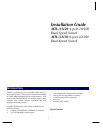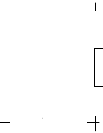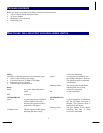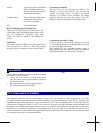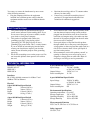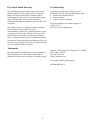
3
Amber A good connection is established,
and the 100 Mbps link pulse is
detected. The operation mode is
negotiated at half duplex.
Flashing Amber The port operates in half duplex,
indicating that data is being
received or transmitted.
Off No link established.
RJ-45 10/100 Dual Speed Switching Ports
There are 4 or 8 RJ-45 ports on the front panel. The
10/100 Mbps speed and full/half duplex modes of the
ports are automatically determined when users
connect the switch to 10Base-T and 100Base-TX
devices.
Uplink Port
One uplink connector (MDI) on the front panel allows
users to connect to a switch or a hub, using straight-
through Category 5 twisted pair cable as figure shown.
Connecting to a desktop
The ports are used for connecting the switch to the
desktops, to form a small network. You can build the
network as the figure shows. To improve the network
efficiency, it is better to have 200 Mbps full duplex
operation between the server and switch if the LAN
adapter on the server can operate in full-duplex mode.
Connecting to a Switch or a Hub
Switch-to-switch or switch-to-hub connections are made
by connecting the uplink port of 10/100 Dual speed switch
to a port of the other hub/switch.
With 100Base-TX, the maximum network length is
approximately 205 meters with UTP cable. The maximum
length between hubs or switch-to-hub is 100 meters.
W
ALL MOUNT
The 4 or 8-port 10/100 Dual speed switch can be mounted
to the wall or to the flat surface
! Screw one of the enclosed 1/2-inch wood screws
into the surface, leaving approximately 1/4-inch of
the threads exposed.
! Hang the switch on the wall using the keyholes
provided on the bottom of the switch.
F
CC COMPLIANCE STATEMENT
This equipment generates and uses radio frequency energy and if not installed and used properly, that is, in strict
accordance with the instructions provided with the equipment, may cause interference to radio and TV reception. The
equipment has been tested and found to comply with the limits for a Class A computing device in accordance with the
specifications in Subpart B of Part 15 of FCC rules, which are designed to provide reasonable protection against such
interference in a residential installation. However, there is no guarantee that interference will not occur in a particular
installation. If you suspect this equipment is causing interference, turn your switch on and off while your radio or TV is
showing interference. If the interference disappears when you turn the switch off and reappears when you turn the switch
on, something in the switch is causing interference.
Wall



